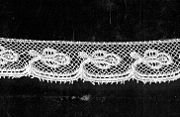
Valenciennes lace
Encyclopedia



Valenciennes lace is a type of bobbin lace
Bobbin lace
Bobbin lace is a lace textile made by braiding and twisting lengths of thread, which are wound on bobbins to manage them. As the work progresses, the weaving is held in place with pins set in a lace pillow, the placement of the pins usually determined by a pattern or pricking pinned on the...
which originated in Valenciennes
Valenciennes
Valenciennes is a commune in the Nord department in northern France.It lies on the Scheldt river. Although the city and region had seen a steady decline between 1975 and 1990, it has since rebounded...
, in the Nord département of France
France
The French Republic , The French Republic , The French Republic , (commonly known as France , is a unitary semi-presidential republic in Western Europe with several overseas territories and islands located on other continents and in the Indian, Pacific, and Atlantic oceans. Metropolitan France...
, and flourished from about 1705 to 1780. Later production moved to Belgium
Belgium
Belgium , officially the Kingdom of Belgium, is a federal state in Western Europe. It is a founding member of the European Union and hosts the EU's headquarters, and those of several other major international organisations such as NATO.Belgium is also a member of, or affiliated to, many...
in and around Ypres
Ypres
Ypres is a Belgian municipality located in the Flemish province of West Flanders. The municipality comprises the city of Ypres and the villages of Boezinge, Brielen, Dikkebus, Elverdinge, Hollebeke, Sint-Jan, Vlamertinge, Voormezele, Zillebeke, and Zuidschote...
. The industry continued onto the 19th century on a diminished scale. By the 19th century valenciennes lace could be made by machine.
Valenciennes lace is made on a lace pillow
Bobbin lace
Bobbin lace is a lace textile made by braiding and twisting lengths of thread, which are wound on bobbins to manage them. As the work progresses, the weaving is held in place with pins set in a lace pillow, the placement of the pins usually determined by a pattern or pricking pinned on the...
in one piece, with the réseau (the net-like ground) being made at the same time as the toilé (the pattern). It differentiates itself from other types of lace because the openness of the réseau, the closeness and evenness of the toilé, which resembles cambric
Cambric
Cambric, pronounced , "one of the finest and most dense species of the cloth manufacture", is a lightweight plain weave cloth, originally from Cambrai, woven in greige, then bleached and piece-dyed, often glazed or calendered. Initially made from flax, then cotton in the 19th century, it is also...
, and that it lacks any cordonnet (a loosely spun silk cord used to outline and define the pattern). Also, in real Flemish Valenciennes lace there are no twisted sides to the mesh; all are closely plaited, and as a rule the shape of the mesh is diamond but without the openings.
The réseau ground is made of four threads braided together, with eight threads at the crosses, which makes it very strong and firm. This is simpler and easier to make than the ground for Mechlin lace
Mechlin lace
Mechlin lace is a bobbin lace originally produced in Mechelen. It is one of the best known Flemish laces. It is fine, transparent, and looks best when worn over another color. It was made in Mecheln, Antwerp, Lier and Turnhout...
, though similar in appearance.
Valenciennes lace received an impetus in the seventeenth century, when the Scheldt
Scheldt
The Scheldt is a 350 km long river in northern France, western Belgium and the southwestern part of the Netherlands...
was channelled for river navigation between Cambrai
Cambrai
Cambrai is a commune in the Nord department in northern France. It is a sub-prefecture of the department.Cambrai is the seat of an archdiocese whose jurisdiction was immense during the Middle Ages. The territory of the Bishopric of Cambrai, roughly coinciding with the shire of Brabant, included...
and Valenciennes
Valenciennes
Valenciennes is a commune in the Nord department in northern France.It lies on the Scheldt river. Although the city and region had seen a steady decline between 1975 and 1990, it has since rebounded...
, benefiting the export of Valenciennes' wool, fabric and fine arts. To use up flax yarn, women began to make the famous Valenciennes lace. Early Valenciennes lace was grounded with fancy mesh which was thicker and closer than the open réseau used later. The more open version was developed in Valenciennes, and thus the type of lace became known under the name of the town. The open mesh started to evolve in the 18th century and by the 19th century the characteristic ground made of four braided threads was in use. By the 1900s little of the famous lace was still made in Valenciennes.

